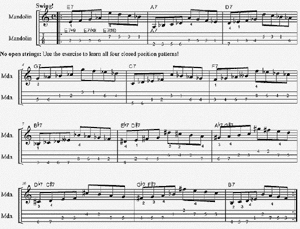 The Altered Scale: Bebop Mandology The Altered Scale: Bebop Mandology
Leaving the safety and complacency of the diatonic world for the edgier vocabulary of the Bebop jazz musician.
The Altered Scale
What is It?
The Altered Scale is fertile fodder for the consummate Bebop musician. Borrowing from two symmetrical scales, the Diminished (1/2, W, 1/2, W, 1/2, W, 1/2, W) and the Whole Tone (W, W, W, W, W, W), two "tetrachords" (four-note patterns) are spliced together to make the culinary equivalent of a chocolate fudge, French vanilla swirl ice cream cone. (1/2, W, 1/2, W,W, W, W)
To the diehard Bluegrass musician or anyone whose feet are permanently planted in the "diatonic" or modal world, this is going to be as foreign as a George Will column to Anna Nicole Smith. It may take your ears (let alone fingers) some getting used to, but if you listen to any Coltrane, Parker, Rollins, it will be familiar. Now, you're going to be able to pick apart what they do, and reproduce it on the fretboard!
Symmetrical Scales


Where is it used?
Jazz is all about tension and resolution. By itself, the Altered Scale is quite a "tense" sound, so its best application is whenever you have a Dominant Functioning Chord (V7, V7 plus extensions, diminished chord, augmented). Used judiciously (and deliciously!) this can be a spicy concoction to give you the recipe for authentic jazz. This will set you apart from ANY Bluegrass-saturated jazz wannabe.
D Altered Scale: in 4 Positions

How do I learn it?
You can play them raw, but what you need to start on immediately is "context." Rarely in music do we play eight notes in linear succession, except in dramatic runs. You want this to be practical. We've developed an exercise, Bebop Mandology, that takes them in their four note (tetrachord) chunks, and mixes the direction, and works this into your brain (and fingers) as dynamically tactile patterns.
In closed position (no open strings), there are only four, one octave patterns, starting with each finger. This will give you the chance to work all four fingerings in the same exercise. Also, because this pattern is best used in a Dominant Function context, you have the opportunity to work these through in the Cycle of Fifths. There are only twelve, and you start all over again!


Click thumbnail to enlarge or download printable PDF.
There are a lot of "Circle of Fifth" inclusive Standards out there you could insert these patterns into: Sweet Georgia Brown, I've Got Rhythm (bridge), Scrapple from the Apple (bridge), All of Me as examples...
Suggestions
- Play it straight, repeat the whole exercise... Indefinitely. Until the cows come home.
- Play each measure, but repeat before going to the next measure.
- Play two measures, repeat in two measure patterns.
- Play every other measure. Go back, start with the 2nd measure and play every other measure.
- Play the first half of the measure as written, but the second half as intervals (3rd).

- Play the first half of the measure as intervals (3rd), but the second half as written.

- Play each measure as intervals (3rd)!

Think of using these patterns like a spice. Curry is delicious in small doses, but you'd get sick of it if every meat dish was served with it (let alone as a desert topping). Think of the Altered Scale as a kind of Taco Seasoning...
Sound Files
 Hear it slow Hear it slow
 Hear it fast Hear it fast
Why closed position?
We advocate working the pinky and establishing "home base" positions that can be easily transposed up and down the fretboard, AND across strings. You'll get the chance to use open strings later, but if you work closed positions hard in practice, they will pay off for you in 3rd & 4th finger independence and strength, and give you the mental and tactile grip on transposable scale positions. Open strings are great for drones, finger gymnastics, and quick position shifts. But for now, learn to close the strings.
Buddy and jazz mentor, Michael Lampert, joked with me, "Nobody plays modes anymore..."
While a slight exaggeration, the truth is, conjunct consecutive eight note riffs aren't that musical, except in "gymnastic" runs, and we do better improvisationally when we break our thought up into four note patterns or tetrachords.
We would be remiss in not acknowledging Scott Tichenor of the Mandolin Cafe. His adaptation of David Baker's 'Perpetual Motion' was admittedly the impetus of the Cycle of Fifths aspect of Bebop Mandology.
Check this one out for another great daily warm up routine! While you're there, take a look at the wealth of great lessons, too!
Take it with you:
Check out our Free Downloads Page! Get a printable version of this and other helpful exercises.

Disclaimer: In the 'Information Age' of the 21st Century,
any fool with a computer, a modem, and an idea can
become a self-professed 'expert." This site does not
come equipped with 'discernment.'
|



